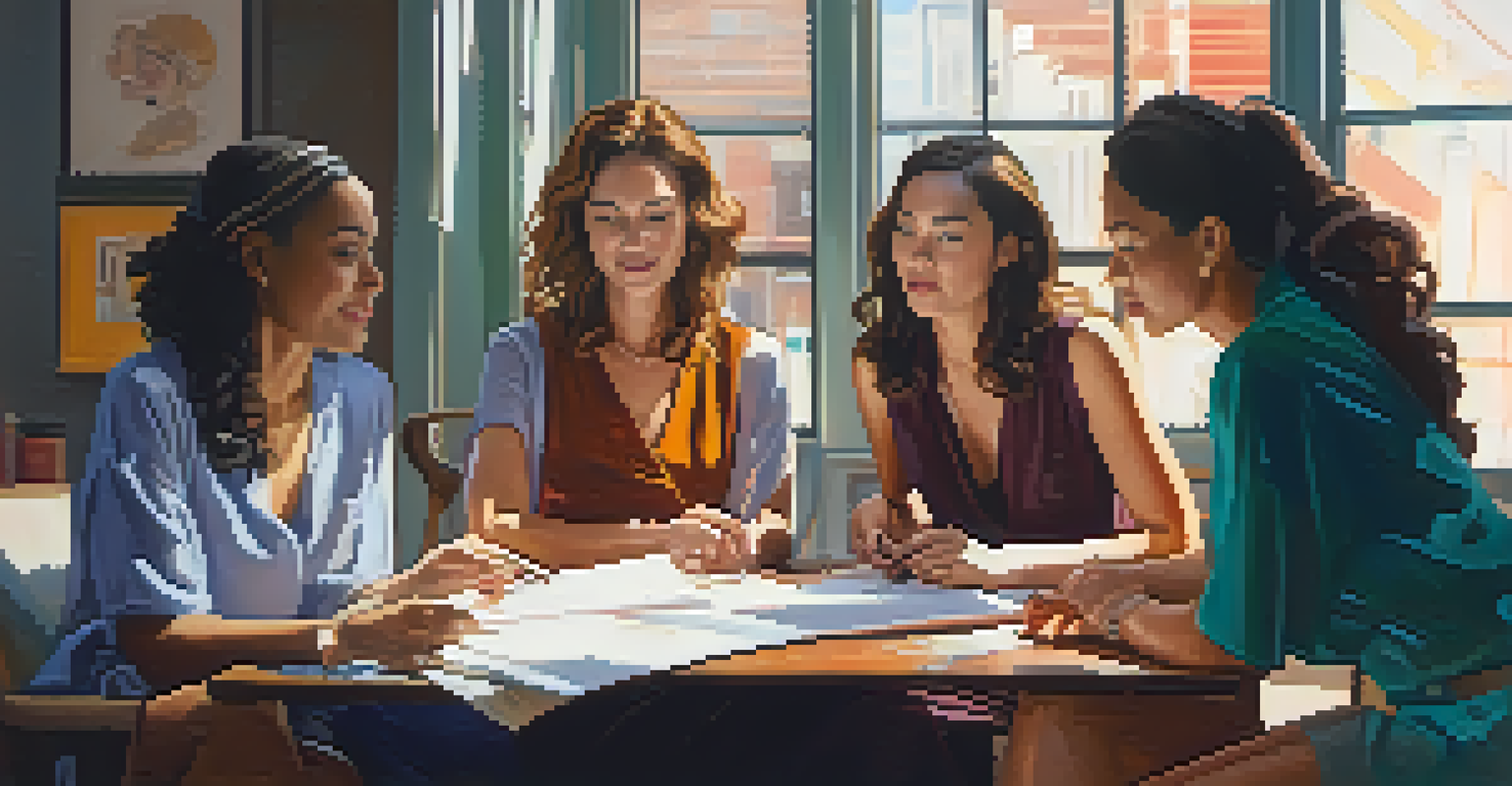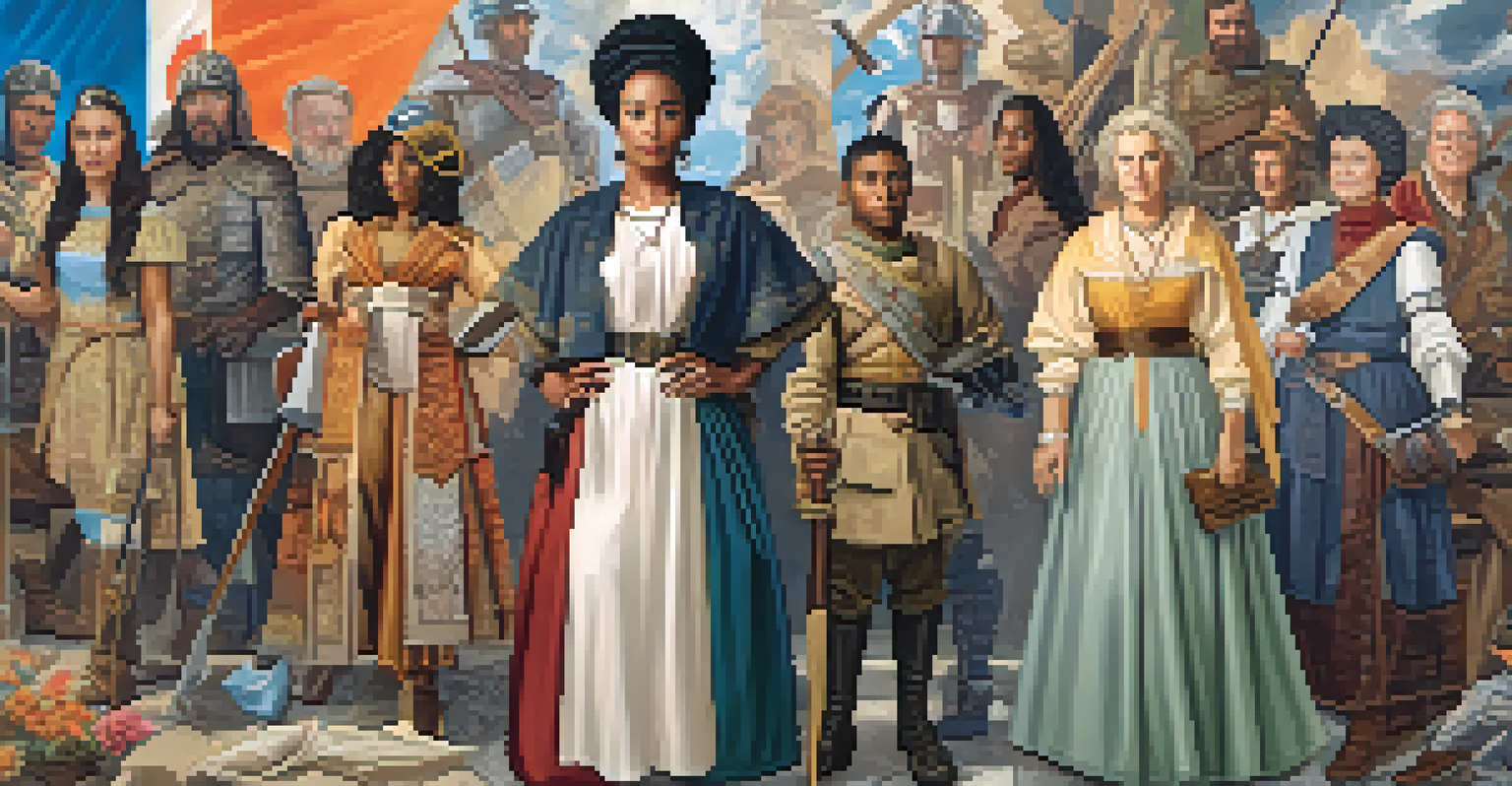The Portrayal of Women in Historical Films: Myths vs. Reality

The Evolution of Women's Roles in Film History
Historical films often reflect societal views of their time, shaping how women are portrayed. In the early days of cinema, women were frequently depicted in limited roles, such as damsels in distress or supportive figures. As film evolved, so did the representation of women, with more complex characters emerging, though often still constrained by stereotypes.
Women are not just the support system; they are the backbone of history.
For example, during the silent film era, women like Mary Pickford were seen as innocent and pure, reinforcing traditional gender roles. As we moved into the 1950s and 60s, films began to show women in more assertive roles, but often still through a male gaze. This evolution highlights the tension between progress and the persistence of outdated stereotypes.
Today, while there are more diverse and powerful female characters in historical films, the question remains: are these portrayals accurate? Understanding this evolution helps us see the broader context of women's representation in media.
Common Myths About Women in Historical Contexts
Many historical films perpetuate myths that women were primarily passive or uninvolved in significant events. For instance, the idea that women were solely homemakers during wartime ignores the countless women who took on roles as nurses, spies, and even soldiers. These myths often serve to simplify complex histories and reinforce traditional gender roles.

A classic example is the portrayal of women in World War II films, where they are often shown in support roles rather than as active participants. However, women played crucial roles in resistance movements and were instrumental in various capacities. This misrepresentation can diminish the real contributions of women throughout history.
Evolution of Women's Film Roles
The portrayal of women in historical films has evolved from limited and stereotypical roles to more complex and empowered characters.
Challenging these myths is essential not only for historical accuracy but also for empowering future generations. By recognizing the multifaceted roles women have played, we pave the way for a more inclusive understanding of history.
The Impact of Stereotypes on Female Portrayals
Stereotypes in historical films can create lasting impressions that shape public perception. For instance, the 'femme fatale' trope often reduces women to one-dimensional characters, making them either seductresses or manipulative figures. This portrayal can overshadow the complexities and strengths women exhibited in real life.
The stories of women are often untold, but they shape the world as much as the stories of men.
Moreover, the tendency to cast women in nurturing or passive roles reinforces societal expectations of femininity. When films depict women as primarily caregivers or romantic interests, they fail to showcase the breadth of women's experiences and capabilities throughout history. It's crucial to challenge these narrow portrayals.
By broadening the lens through which we view women's roles, filmmakers can contribute to a more nuanced understanding of history. This not only enriches the narrative but also allows audiences to connect with and appreciate women's diverse contributions.
Positive Shifts in Portrayal: Recent Trends
In recent years, there has been a noticeable shift towards more accurate and empowering portrayals of women in historical films. Directors and writers are increasingly committed to showcasing women's stories that highlight their strength, intelligence, and complexity. This change reflects a growing awareness of the importance of representation.
Films like 'Hidden Figures' and 'The Favourite' offer refreshing perspectives on women's roles in history, illustrating their agency and significance. These narratives not only entertain but also educate audiences about the real-life women who defied societal norms. They challenge the traditional portrayals that have persisted for decades.
Challenging Myths in History
Common myths about women's passive roles in history overlook their significant contributions, emphasizing the need for accurate representations.
This trend is encouraging as it opens the door for more varied storytelling. As more filmmakers embrace diverse narratives, we can expect to see an even richer tapestry of women's experiences represented on screen.
The Role of Female Filmmakers in Changing Narratives
Female filmmakers are at the forefront of reshaping the portrayal of women in historical films. With unique perspectives and experiences, they bring authenticity and depth to their storytelling. Their contributions help to challenge stereotypes and highlight the diverse roles women have played throughout history.
For example, directors like Greta Gerwig and Ava DuVernay have created films that not only focus on women's stories but also challenge conventional narratives. Their work encourages audiences to rethink historical events from a female perspective, showcasing the complexities that have often been overlooked.
The rise of female filmmakers is a vital step towards more balanced representations. As they continue to break barriers, we can hope for a future where women's stories are told with the respect and nuance they deserve.
Audience Reception: How Viewers Respond to Portrayals
Audience reception plays a critical role in shaping how films portray women. Viewers often respond positively to films that present nuanced and empowering female characters, leading to increased demand for similar content. This feedback loop can influence filmmakers to create more authentic narratives.
For instance, films that challenge stereotypes tend to resonate with audiences who seek representation that reflects real-life experiences. As viewers become more vocal about their preferences, the industry is forced to adapt, resulting in a broader spectrum of portrayals.
Impact of Female Filmmakers
Female filmmakers are reshaping narratives by providing authentic perspectives that highlight the diverse roles women have played throughout history.
Ultimately, audience engagement can drive change in Hollywood. By supporting films that accurately represent women, viewers contribute to a cultural shift that values diverse storytelling and empowers future filmmakers.
Looking Ahead: The Future of Women in Historical Films
As we look toward the future, the portrayal of women in historical films holds great potential for growth and transformation. With an increasing number of voices advocating for accurate representation, we may witness a continued shift away from stereotypes. This change could lead to richer narratives that honor women's contributions.
Moreover, as technology and storytelling techniques evolve, filmmakers can experiment with new ways to tell women's stories. This innovation presents an opportunity to blend historical accuracy with creative storytelling, allowing for more engaging and educational experiences.

In this evolving landscape, it is essential to support and uplift diverse voices in filmmaking. By doing so, we can ensure that the portrayal of women in historical films reflects the complexity and richness of their real-life counterparts.